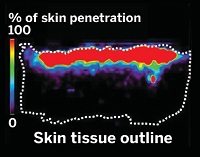 |
| DESI-MS imaging shows the percentage of lidocaine migrating in a skin sample.--Courtesy of the Journal of the American Chemical Society |
A team of chemistry professors at Stanford University has developed a method to monitor chemicals as they enter the skin, giving them a better idea of how fast and by which pathways the small molecules permeate the surface. The desorption electrospray ionization-mass spectrometry (DESI-MS) technique they used has been implemented in the past to image tumor surfaces and can be used without radioactive labeling that could affect the absorption of the chemicals. The chemists sprayed droplets of the drugs, including lidocaine, with an electric charge at the skin surface and tracked them to a depth of 1.2 millimeters, according to a report from Chemical & Engineering News. "Determining permeability of a given compound through human skin is a principal challenge owing to the highly complex nature of dermal tissue," the team, led by Justin Du Bois, wrote in the abstract published in the Journal of the American Chemical Society. "Our simple and label-free approach enables successful mapping of the transverse and lateral diffusion of small molecules having different physiochemical properties without the need for extensive sample preparation." More | Abstract